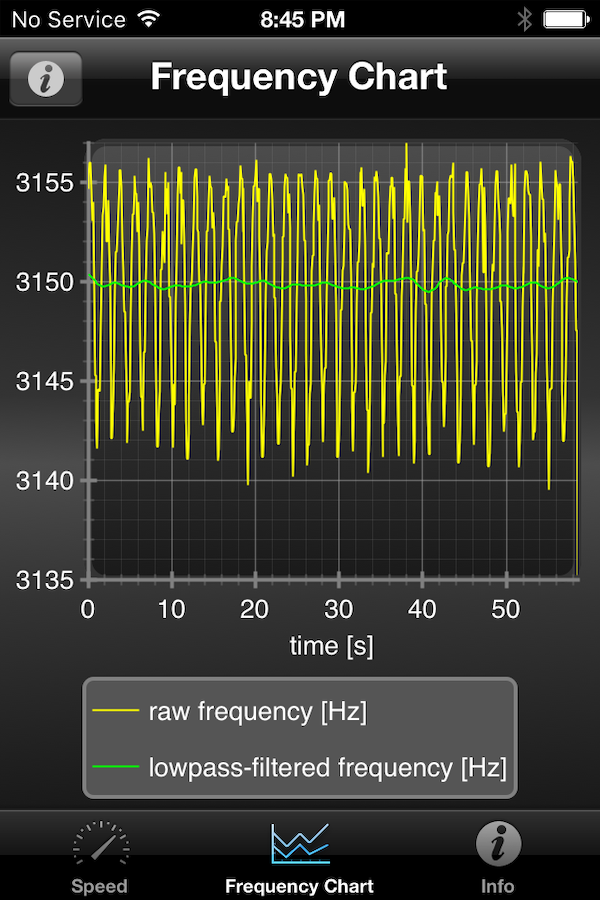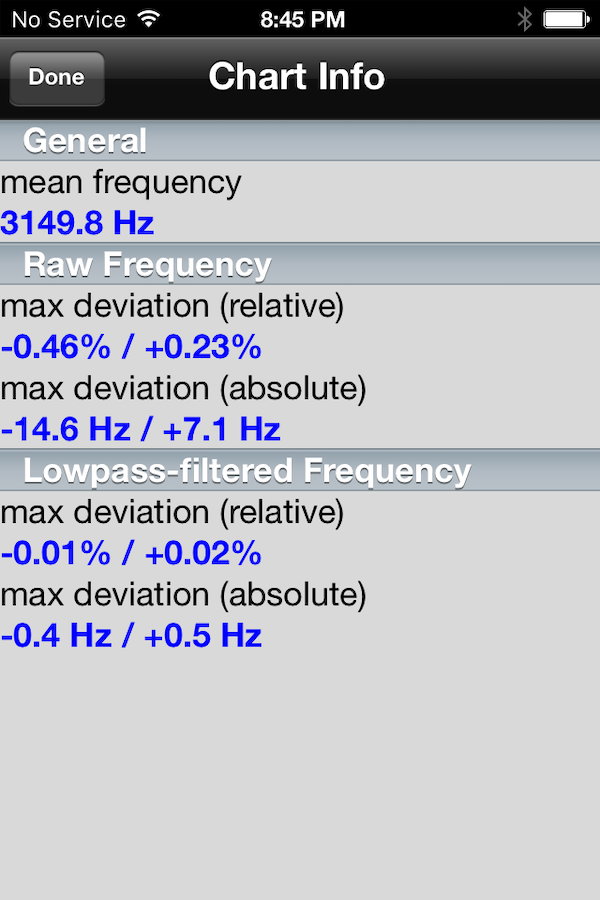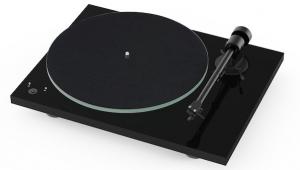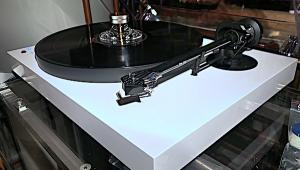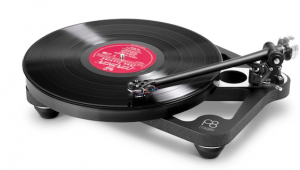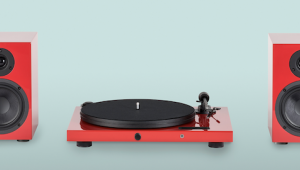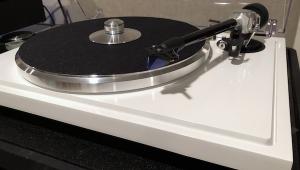So an MC cart with a built-in MM preamp? And no external phono pre? Am I missing something?
Cambridge Audio’s Alva—A Serious Plug’n’Play Direct Drive Turntable
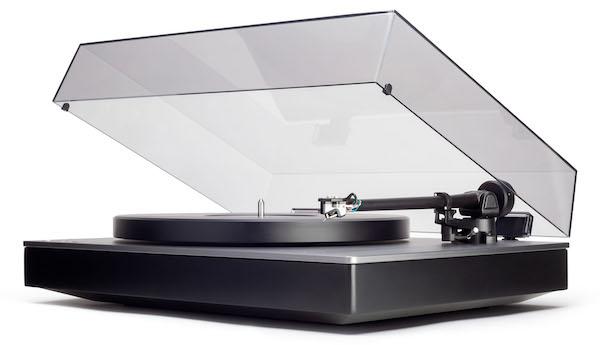
The five pound, twelve inch platter is of nicely machined POM (polyoxymethylene) fitted with a tapered metal insert that fits on a substantial (especially for this price-point) spindle assembly.
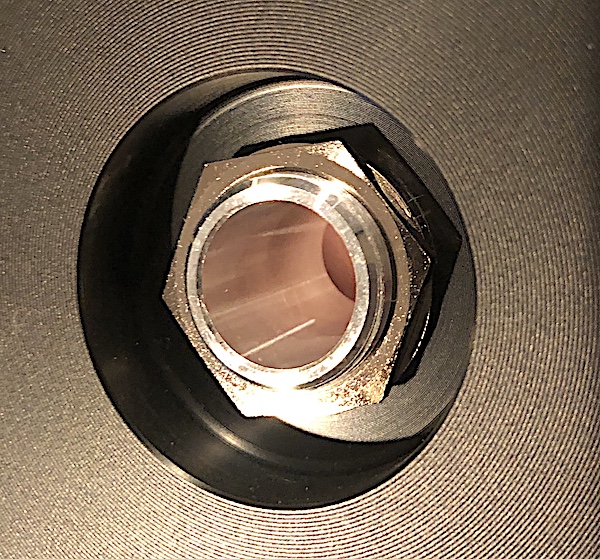
I doubt Cambridge designed its own direct drive motor and drive system but since I’m guessing I could be wrong. My guess, based on the excellent measured speed consistency and accuracy, is that Cambridge sourced it from the same Taiwanese company that supplied Thorens with the motor used on its TD 402 but that’s just a guess and the source doesn’t much matter. The performance does.
Cambridge went with a cast aluminum arm tube Rega OEM RB250 or variant thereof with an effective length of 238mm and an effective mass of 11 grams—not that buyers need worry about that or much of anything else as the complete set-up is both easy and well-explained in the comprehensive manual.
A Cambridge Audio designed high output MC cartridge fitted with an elliptical sylus that tracks at 2 grams comes pre-installed. The built-in MM phono preamp is based on Cambridge’s well-regarded (and well-reviewed) $179 Alva Solo stand-alone phono preamp. Of course, in addition to the wireless output, the rear panel includes a pair of RCA jacks for connection to a preamplifier or integrated amp.
Cambridge chose to not give buyers the option of substituting an outboard phono preamplifier, which in this case makes complete sense. The goal, after all, was a stand-alone, fully functional, high quality plug’n’play turntable. If you needed proof that simple and low key looks can be both elegant and pleasing, have a look at the Alva turntable.
Easy Set-Up And Use
The well-illustrated manual explains set-up in five easy to understand and accomplish steps. I just wish Cambridge had cautioned buyers to be sure to place the turntable on a level surface and had added a few recommendations about on what and where to and where to not locate the turntable.
Here’s how easy is the set-up: once in place, put the platter on the spindle, push the counterweight onto the tone arm’s rear stub, remove the stylus protector, use the supplied Ortofon stylus gauge to set 2 gram VTF (good instructions here, taking nothing for granted about the end-user’s set-up knowledge), set the anti-skating to 2, place the dust cover on the hinges, connect the turntable to the electronics (if desired) and plug it in! That’s it. The auto-shutdown mode turns the Alva off after 20 minutes of inactivity or you can disable it by holding down the power button for five seconds in standby mode. To restore auto-shutdown, hold down the power button when plugging in the A.C.
The Bluetooth can be turned on or off. A single blue LED associated with a single push button lets you know status: fast flashing means “pairing mode”, slow flashing means “looking for last paired device”, solid means paired to a device and long solid intervals means paired to an aptX/apt X HD device. To go into “pairing mode” push and hold down the button for 2 seconds.
Measured and Sonic Performance
Speed accuracy and consistency are jobs one and two for any turntable. The Alva gets high marks for both without regard to price:
Here’s the joke: the Alva sits on what appear to be thin, simple discs—almost nothing— yet the ‘table’s isolation from impulse type taps on the surface upon which it’s placed is effective and betters that of many costly turntables I’ve encountered over the years. Some of those sit on what look like heroic, well-engineered, complex footers but which accomplish nothing in terms of isolation other than to look good!
That’s also true of the plinth itself, here, which when tapped with the record playing produces through the speakers a low to moderate level, quickly evaporated “tap” through the speakers (the level and frequency of which depends upon where you tap).
How is it that Cambridge has managed to do what some veteran turntable designers seem incapable of doing? Which is not to say these impulse type tests are necessarily predictive of sonic performance, but they do offer a clue.
The Cambridge Audio designed cartridge tracked the Ortofon test record’s 70µm peak band and produced only the mildest of mistracking buzz on the 80µm peak band, indicating good tracking ability, which was confirmed with music.
Warm, Definitely Warm, Yet Detailed Sound
The timbral balance here is definitely on the warm side. I played the Analogue Productions double LP set The Wonderful Sounds of Female Vocals (APP 122) and the warmth was obvious throughout. The Alva added a pleasing layer of warmth to Julie London’s voice on “Cry Me A River” and Ella Fitzgerald’s on “Black Coffee”. The ‘table’s effective damping probably helped prevent runaway mid-bass bloat, which was never an issue on these female voices or on bass-heavy instrumentals on other records.
I can easily imagine that this balance might be ideal played through small two-way stand mount speakers, unless those speakers boost mid-bass to appear to have real low frequency extension. On my big speakers Shelby Lynne’s deep bottomed “Just A Little Lovin” demonstrated that the Alva’s bottom end goes deep and is well-controlled. The bass line’s attack was well-presented and texturally pleasing. Sustain was natural and decay was fast indicating the warmth is probably associated more with the cartridge and/or phono preamp than with a coloration produced by a mechanical deficiency. However, as with the other ladies’ voices, there was a “down the hall” added warmth to Shelby’s voice. The virtuoso triangle on Rickie Lee Jones’s version of Steely Dan’s “Showbiz Kids” wasn’t softened but it lost some percussive ring, and “air” was in short supply.
Pairing was quick and easy with my RIVA Audio Turbo-X aptX equipped Bluetooth speaker. The sound produced through it was, as I expected, actually better balanced than through my big speakers. Guess what? I don’t think Cambridge Audio’s engineers designed the Alva to sound great on $110,000 loudspeakers—not that it sounded bad!
Conclusion
Cambridge Audio’s Alva is a well-engineered, fine performing “plug’n’play” turntable that offers a high level of build and sonic quality for $1699. It’s aimed at people who want a “no fuss”, easy to set-up and use vinyl playback experience and in my opinion, it scores a bullseye—especially for music fans looking to come in from the digital cold.
I’ve not read any previous Alva reviews. Maybe you have. I’ll say this: if they don’t mention the predominant pleasing warmth, the reviewers couldn’t have been listening! That said, it’s clear, given everything else about this product, that it was Cambridge’s intention to produce the pleasingly warm sound. Mission well-accomplished.
- Log in or register to post comments


You usually (if not always?) use an MM phono stage with High Output MC cartridges.

The T+A G 2000 R (which I own and love more than my old AMG Giro) and the SME Synergy are indeed “ serious, well-engineered one that combines set up ease with high performance” antecedent alternatives (both spec with built-in phono stages) but this looks, measures, and reviews like a pleasing option and strong value. Thanks for the review. :)

Michael, I’m definitely sympathetic with privileging the singularity of the Cambridge among price-equivalent competitors, but so many of your readers can actually afford the Synergy. I can’t, wait Hochschule is why I close the T+A, but this Cambridge checks a lot of boxes. Nevertheless, as a millennial reader / music lover, I do have to say that if I were looking for convenience or warmth, I’d likely put it elsewhere in my chain as the whole pint of vinyl for me is to escape the attention-sapping convenience of jumping across tracks with media and, mainly, the verisimilitude from my sources (in a world that’s already so synthetic). This is why I chose the T+A (with Quintet Black MC S) and the AMG (with Hana ML) before it. Your reviews really helped with the carts, as I know so few more experienced music lovers to give me experienced advice.

... this set-up, I'd want to compare it with a Technics SL-1200MK7 + an Ortofon MC3 Turbo + a Pro-Ject Phono Box S2 Ultra.
https://www.technics.com/us/products/dj-series/direct-drive-turntable-sy...
https://www.ortofon.com/mc-3-turbo-p-553
https://www.project-audio.com/en/product/phono-box-s2-ultra/

... the equipment is purchased, the dealer may be able to install the cartridge.
Perhaps you could do a follow-up article discussing the pros and cons of buying a PnP turntable set-up versus selecting the turntable, cartridge and phono stage à la carte. For example, is any sound quality being traded off in the name of one-box convenience? Or, does a PnP unit possibly have components that are better matched to one another than might be achieved by choosing them individually?

Sounds like the Technics 1500c may be the better table at about $400 cheaper. Plus, option to use outboard phono if needed. The built in bluetooth is the big difference.

Michael, I have a question that maybe you or someone else might be able to help me understand. As this table is a “plug’n’play” it would appear to be directed towards music lovers who don’t want to get into mounting a cartridge, aligning, etc., yet it ships with a MC cartridge that I assume does not have a replaceable stylus. So what happens when the stylus is worn out, does the owner need to package the whole table up and send it back for re-tipping? It would seem to me that “plug’n’play” tables should have a cartridge with a user replaceable stylus, considering the market. Thanks.

Well, because of the design of MC carts and how they work, one can't just replace the stylus, which I agree is a real bummer. One can however, just send the cartridge in to be retipped. Alternatively, for that kind of scratch one can get a killer MM cart in which one can replace the stylus. MC carts are not better than MM nor are MM carts better than MC, they are just different and a matter of preference. I have heard bad examples and great example of both.
That's all I have in answer to the question.

The build on this table sounds almost too good to be true. Good DD tables run more than $1600 now days. One can get a fabulous belt table for $1600. I'm a DD table fan myself though. I have all DD tables, the trick to that though is that all my tables are vintage, but deadly accurate all the same, which is somewhat unusual. (yes, all tested).
Of course they don't have built-in preamps or bluetooth, but I want none of that on my tables. That's just me though and not the point of the Cambridge table.
If I needed to replace one of my tables (a highly unlikely event unless they get destroyed by nature or something), I would seriously consider this table....if I could have it without the built-in amp and bluetooth and such, just the table.

I'm interested in the new SC-2 MINI/PHONO with builtin phone stage but have not been able to find any reviews.
Has anyone had a good experience ordering from Sweetwater since the pandemic/lock down began?
I'd love to hear some feedback from buyers of the Sugarcube line before I plunked down $3,000.
